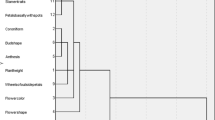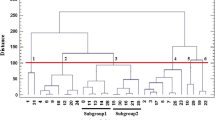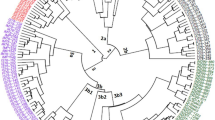Abstract
The Xinan tree peony cultivar group, one of four Chinese peony cultivar groups, is distributed sparsely throughout Southwest China. This study aimed to characterize its genetic diversity and its genetic relationships with other peony groups. A total of 96 specimens from seven groups of different geographical provenances were collected and their genetic similarity was analyzed based on sequence-related amplified polymorphism molecular markers. Twenty primer pairs were selected to detect DNA polymorphisms. A total of 868 bands were generated with an average of 43.4 bands per primer pair and 98.39% polymorphic ratio. The genetic similarity coefficient varied from 0.5081 to 0.9173. The closest phylogenetic relationship was found between hybrids 2 and 3 of Paeonia rockii, while the farthest genetic relationship was between P. lutea and P. suffruticosa ‘Bangningzi’. Among the 20 Xinan samples the genetic similarity coefficient ranged from 0.6351 to 0.8710, revealing slight genetic variation. The 96 cultivars clustered into five branches at the genetic similarity coefficient of 0.6419. The results revealed that the Xinan group has a closer relationship with Japanese, French and American groups. Additionally, these results show that the phylogenetic relationships of different tree peony germplasms correspond to their origins and are primarily related with flower color.


Similar content being viewed by others
References
Chen XM, Zheng GS, Zhang SW (2001) RAPD analysis of tree peony cultivars. Acta Hortic Sin 28:370–372
Chen XM, Zheng GS, Meng L (2002) RAPD-PCR analysis of genetic diversity of different color varieties 35 tree paeonia cultivars. Sci Agric Sin 35:546–551
Cheng FY (2007) Advances in the breeding of tree peonies and a cultivar system for the cultivar group. Int J Plant Sci 1:89–104
Ferriol M, Pico B, Nuez F (2003) Genetic diversity of a germplasm collection of Cucubita pepo using SRAP and AFLP marker. Theor Appl Genet 107:271–282
Gao ZM, Wu J, Liu ZG, Wang LS, Ren HX, Shu QY (2013) Rapid microsatellite development for tree peony and its implications. BMC Genom 14:886–896
Guo DL, Hou XG, Zhang J (2009) Sequence-related amplified polymorphism analysis of tree peony (Paeonia suffrutiosa Andrew) cultivars with different flower colors. J Hortic Sci Biotechnol 84:131–136
Han XY, Wang LS, Liu ZA, Jan DR, Shu QY (2008a) Characterization of sequence-related amplified polymorphism markers analysis of tree peony bud sports. Sci Hortic 115:261–267
Han XY, Wang LS, Shu QY, Liu ZA, Xu SX, Tetsumura T (2008b) Molecular characterization of Tree Peony germplasms using sequence-related amplified polymorphism markers. Biochem Genet 46:162–179
Hao Q, Liu ZA, Shu QY, Zhang R, De RJ, Wang LS (2008) Studies on Paeonia cultivars and hybrids identification based on SRAP analysis. Hereditas (Lund) 145:38–47
Hou XG, Yin WL, Li JJ, Wang HF (2006a) AFLP analysis of genetic diversity of 30 tree peony (Paeonia suffruticosa Andr.) cultivars. Sci Agric Sin 39:1709–1715
Hou XG, Yin WL, Li JJ, Wang HF (2006b) Phylogenetic relationship of dwarf tree peony cultivars by AFLP analysis. J Beijing For Univ 28:73–77
Li JJ (1998) Study on the origin of peonies in China. J Beijing For Univ 20:22–26
Li JJ (1999) Chinese Tree Peony and Paeonia lactiflora. China Forestry Press, Beijing, pp 107–113
Li JJ (2006) Pictorial record of Chinese Tree Peony varieties (Volume Xibei Xinan Jiangnan). China Forestry Press, Beijing, pp 93–97
Li G, Quiros CF (2001) Sequence-related amplified polymorphism (SRAP) a new marker system based on a simple PCR reaction: its application to mapping and gene tagging in Brassica. Theor Appl Genet 103:455–461
Li YY, Zheng CS (2013) Genetic diversity of tree peony cultivars resources in Heze revealed by CDDP markers. Sci Agric Sin 46:2739–2750
Li ZY, Qin YL, Meng JF, Tang D, Wang J (2015) Study on the origin of tree peony cultivars from southwest China based on ISSR technology. Sci Agric Sin 48:931–940
Meng L, Zheng GS (2004) Phylogenetic relationship analysis among Chinese wild species and cultivars of Paeonia sect. Moutan using RAPD marker. Sci Silvae Sin 40:110–117
Rohlf FJ (2000) NTSYS-pc numerical taxonomy and multivariate analysis system. Version 2.1. Exeter Software, Applied Biostatistics Inc, Setauket
Shi YT, Zhou B, Zhang XX, Jiang DH, Xue JQ, Wang ShL (2012) Assessment of genetic diversity and relationship of 89 tree peony cultivars from different provenances. Acta Hortic Sin 39:2499–2506
Suo ZL, Zhang HJ, Zhang ZhM, Chen FF, Chen FH (2005) DNA Molecular evidences of the hybrids between Paeonia rockii and P. suffruticosa based on ISSR marker. Acta Bot Yunnancia 27:42–48
Suo ZL, Zhang ChH, Zheng YQ, He LX, Jin XB, Hou BX, Li JJ (2012) Revealing genetic diversity of tree peonies at micro-evolution level with hyper-variable chloroplast markers and floral traits. Plant Cell Rep 31:2199–2213
Wang JX (2010) Study on the evolutionary biology of leathery faceplate subgroup of paeoniaceae and the origin of traditional peony cultivars. CDDBFT
Wang Z, Wang JE, Wang XM, Gao HW, Dzyubenko NI, Chapurin VF (2012) Assessment of genetic diversity in Galega officinalis L. using ISSR and SRAP markers. Genet Resour Crop Evol 59:865–873
Wang XW, Fan HM, Li YY, Sun X, Sun XZ, Wang WL, Zheng CS (2014) Analysis of genetic relationships in tree peony of different colors using conserved DNA-derived polymorphism markers. Sci Hortic 175:68–73
Yeh FC, Yang RC, Boyle T, Ye ZH, Mao JX (1999) POPGENE version 1.32: the user friendly software for population genetic analysis. University of Alberta, Edmonton
Yu L, Li JJ, He LX (1997) Comparative studies on chromosome in varieties of Paeonia rockii and Paeonia suffruticosa. Acta Hortic Sin 24:79–83
Yu HP, Cheng FY, Zhong Y, Cai CF, Wu J, Cui HL (2013) Development of simple sequence repeat (SSR) markers from Paeonia ostii to study the genetic relationships among tree peonies (Paeoniaceae). Sci Hortic 164:58–64
Yuan T, Wang LY (2002) Discussion on the origination of Chinese tree peony cultivars according to pollen grain morphology. J Beijing For Univ 24:5–11
Yuan T, Wang LY (2004) Study on the origination of Chinese tree peony cultivars based on morphological analysis. J Shandong For Technol 6:1–3
Zhang YM, Zhang ZP, Wang SD (1988) Study on leaf anatomy of genus Paeonia. J Henan Agric Univ 22:117–126
Zhang Y, Chen B, Zhao H, Zhao YY, Liu F (2008) Genetic comparability analysis of seven accessions of Brassica oleracea var. acephala, Mol. Plant Breed 6:309–315
Zhang YX, Zhang XR, Hua W, Wang LH, Che Z (2010) Analysis of genetic diversity among indigenous landraces from sesame (Sesamum indicum L.) core collection in China as revealed by SRAP and SSR markers. Genes Genom 32:207–215
Zou YP, Cai ML, Wang ZP (1999) Systematic studies on Paeonia sect. Moutan DC. based on RAPD analysis. Acta Phytotax Sin 37:220–222
Acknowledgements
This project was supported by Doctors Foundation of Southwest Forestry University (111609) and China Scholarship Council Project (201707855002).
Author information
Authors and Affiliations
Corresponding author
Rights and permissions
About this article
Cite this article
Li, Z., Yang, K., Zhao, Y. et al. Genetic diversity analysis based on sequence-related amplified polymorphism (SRAP) reveals the genetic background of Xinan tree peony group cultivars from different geographical provenances. Hortic. Environ. Biotechnol. 59, 567–574 (2018). https://doi.org/10.1007/s13580-018-0060-9
Received:
Revised:
Accepted:
Published:
Issue Date:
DOI: https://doi.org/10.1007/s13580-018-0060-9




